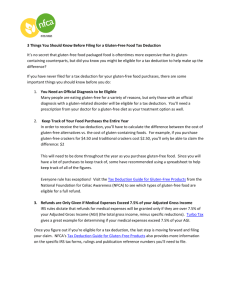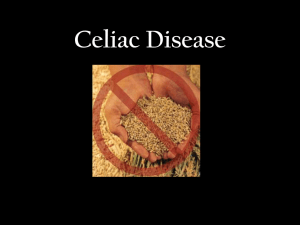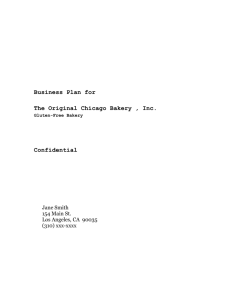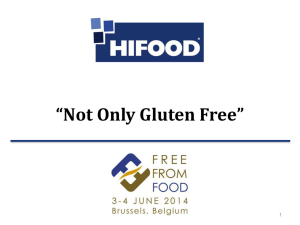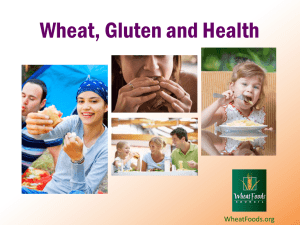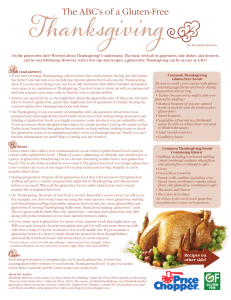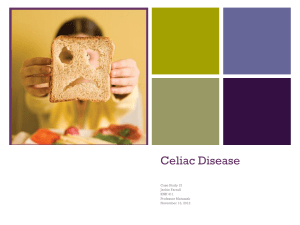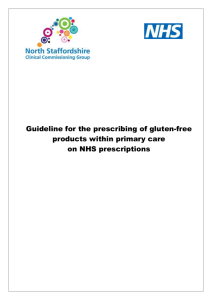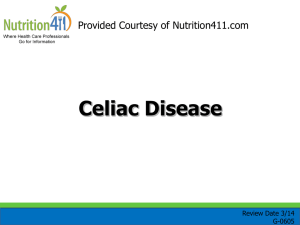Handout
advertisement
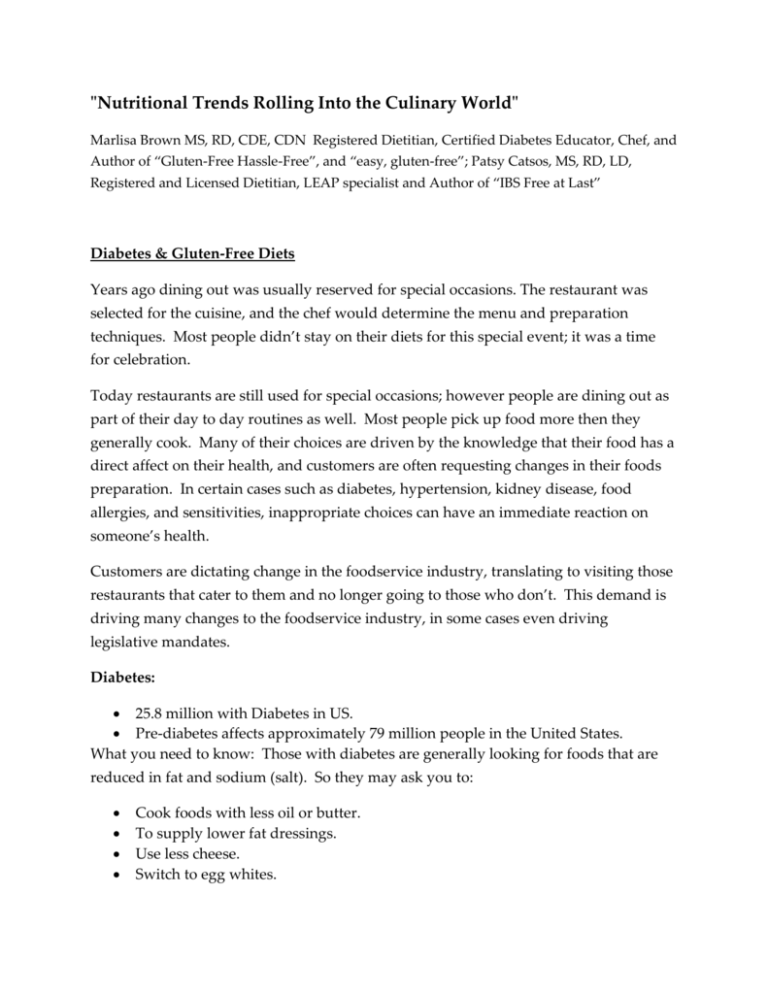
"Nutritional Trends Rolling Into the Culinary World" Marlisa Brown MS, RD, CDE, CDN Registered Dietitian, Certified Diabetes Educator, Chef, and Author of “Gluten-Free Hassle-Free”, and “easy, gluten-free”; Patsy Catsos, MS, RD, LD, Registered and Licensed Dietitian, LEAP specialist and Author of “IBS Free at Last” Diabetes & Gluten-Free Diets Years ago dining out was usually reserved for special occasions. The restaurant was selected for the cuisine, and the chef would determine the menu and preparation techniques. Most people didn’t stay on their diets for this special event; it was a time for celebration. Today restaurants are still used for special occasions; however people are dining out as part of their day to day routines as well. Most people pick up food more then they generally cook. Many of their choices are driven by the knowledge that their food has a direct affect on their health, and customers are often requesting changes in their foods preparation. In certain cases such as diabetes, hypertension, kidney disease, food allergies, and sensitivities, inappropriate choices can have an immediate reaction on someone’s health. Customers are dictating change in the foodservice industry, translating to visiting those restaurants that cater to them and no longer going to those who don’t. This demand is driving many changes to the foodservice industry, in some cases even driving legislative mandates. Diabetes: 25.8 million with Diabetes in US. Pre-diabetes affects approximately 79 million people in the United States. What you need to know: Those with diabetes are generally looking for foods that are reduced in fat and sodium (salt). So they may ask you to: Cook foods with less oil or butter. To supply lower fat dressings. Use less cheese. Switch to egg whites. Not to add salt or other foods high in salt such as soy sauce, or bases as part of their meal. Recipes or nutrition facts should have mg sodium and gm of fat per serving, along with the serving size. In addition those with diabetes will need to keep their carbohydrates within a certain range. Carbohydrate counting is essential for them to maintain normal blood sugars or to match up their insulin or medications with the amount carbohydrates they are consuming. So if they are trying to reduce their blood sugars they will usually be looking for a max of about 1/3 of their plate to be fruit or starch, 1/3 to be a protein source (such as chicken, fish or lean beef) and 1/3 or more on the side of non starchy veggies. This can translate into different requests and behaviors; food being taken home or discarded requests on the types of sides, as well as requests for sugar-free options. When reading a recipe or nutritional fax panel they will be looking for serving sizes along with a list gm of carbohydrates and fiber. By contrast, if their sugars are low they will be looking for foods high in carbohydrates for immediate consumption, to help their sugars increase. Low blood sugar can be more of an emergency situation, so if someone has taken their medication and there is a delay in food service, there can be an immediate reaction. Usually they are looking for pure sugar such as juice, regular soda, sugar packets, milk, or something sweet. Gluten Sensitivities: Why Is There Increased Demand for Gluten-Free Diets? WHO (The World Health Organization) estimates that the prevalence of celiac disease is 1 in 100 people worldwide (the only treatment for celiac disease is a gluten-free diet). Increase of the prevalence celiac disease (an auto immune disease) 4-5x in the past 50 years Recent identification of gluten sensitivity. Screening for gluten-intolerance has increased. Identification of non-typical symptoms of celiac disease. More research and awareness involving gluten-intolerance Why there is an Increased Demand for Gluten-Free Food? Reasons listed previously plus the following: Parents trying gluten-free diets as a treatment to help with behavior disorders in children. People trying gluten-free diets because they say it makes them feel better. More Education about who needs to follow a gluten-free diet. Some use it as a FAD diet Increase in Demand for Gluten-Free Diets has Lead to Changes in the Food Service Industry: Gluten-free sales increased over 30% in 2010 approx: 2.6 billion. Additional increases over $3.9 billion in 2012. Many new products are listing a gluten-free claim on their labels. The trend began with small companies, and bakeries. Initial sales in specialty and health food stores. Trend has brought major manufacturers into the game. Estimated Numbers for Medical Reasons to Follow Gluten-Free Diets in the United States: 1 % of population with celiac disease (approx: 3 million people) 5-7 % of population with wheat allergies (approx: 15-20 million people) 6 % of population estimated with gluten sensitivity (approx: 18 million people) These numbers do not include those who just feel better gluten-free, children with behavior problems on gluten-free diets, those with gastrointestinal issues who are negatively affected by the intake of gluten, and those who are just following gluten-free diets as a FAD. Note misinformation is circulating in the foodservice industry on what is a safe way to provide gluten-free foods. This misinformation has been leading to many people becoming ill. ANATOMY OF A LOW FODMAP* RECIPE Many of your favorite recipes can be easily adapted for use during a low FODMAP diet. The first step is to identify high FODMAP ingredients in your recipe, and to figure out what the function of that ingredient is in the original recipe. You can then substitute a lower FODMAP ingredient that serves the same function. Sometimes you might have to adjust other ingredients to preserve the overall volume, flavor, or consistency of the recipe. These examples illustrate some of the considerations you may need to take into account: Salsa With Black Beans Ranchero 8 ounce can tomato sauce 6 ounce can tomato paste 14.5 ounce can Muir Glen organic, fire roasted, diced tomatoes or 4 cups tomatoes, peeled, chopped, drained 1 ¼ cups onions, chopped 1 small bunch scallions, green parts only 2 cloves teaspoons garlic-infused oil, minced ½ tsp black pepper ½ teaspoon salt (or more, to taste) 3 tablespoons vinegar fresh lime juice ½ cup fresh cilantro, finely chopped 8 ounce can black beans, drained 1 cup corn, frozen 1 large green bell pepper, finely chopped Starting from the top, replace the other tomato products with the Muir Glen fire roasted diced tomatoes in tomato juice. Unless fresh garden tomatoes are in season, go with a 28-ounce can of Muir Glen—the flavor of the fire roasted tomatoes is outstanding, and what could be easier than opening a can? Replace the onions with paper thin slices of the scallion greens . Oil is not a typical salsa ingredient; in this recipe we are using garlic-infused oil to get the flavor without the FODMAPs. Increase the salt if using fresh tomatoes; canned tomatoes have salt added already. Replace the vinegar with fresh lime juice for an extra flavor punch. Replace the beans and corn with chopped green bell pepper for visual interest and crunchy texture. This party-sized batch of salsa tastes outstanding, and is now low in FODMAPs! *FODMAPs are Fermentable Oligo- Mono and Disaccharides and Polyols. They are certain sugars and fibers in the diet capable of causing distressing for many people with irritable bowel syndrome (IBS). Recipe adapted from Love the Foods that Love You Back by Patsy Catsos, MS, RD, LD (Pond Cove Press). Common High-FODMAP Foods or Ingredients Popular Low-FODMAP Alternatives Regular milk, yogurt, ice cream or ice cream; goat milk Lactose-free cow’s milk, yogurt, ice cream, rice or coconut milk beverage Cottage or ricotta cheese Cheddar, Swiss, Parmesan, havarti, brie, camembert, gorgonzola and other hard and/or aged cheeses; small amounts of fresh goat cheese. Dried fruit, fruit juice, trail mix, fruit bars or leathers Apples, pears, stone fruits (cherries, peaches, prunes, apricots, avocados, mango), watermelon, blackberries Small portions (1/2 cup) fresh or frozen fruit Broccoli, cauliflower, Brussels sprouts, cabbage, mushrooms, sweet corn Spinach, lettuce, fresh tomatoes, cucumber, carrots, zucchini, bell peppers, white potatoes. Small portions (1/2 cup) of green beans, peas, sweet potato Wheat, barley or rye; breads, cereals, pastas or baked goods made of wheat, barley or rye; highfiber bars or cereals Oats, rice, cornmeal, spelt or quinoa; breads, cereals, pastas or baked goods made of oats, rice, cornmeal or quinoa; sourdough breads in general Sugar-free candy sweetened with sorbitol, mannitol, maltitol Small portions (1-2 ounces) of sugar-sweetened candy Canned, baked or refried beans, edamame, hummus, soy milk Pistachios, cashews Firm tofu, tempeh, canned, drained chickpeas or lentils, Quorn ground/mince Small portions (1 handful) of other nuts, nut butters or seeds Garlic and onions Garlic-infused oil and garlic scapes, chives, scallion greens, parsley, basil, dill and other leafy herbs, sweet spices Beverages, syrups or condiments sweetened with granulated sugar, evaporated cane juice, brown sugar, 100% pure maple syrup, brown rice syrup, stevia Beer, red or white wine, gin, vodka, whiskey Beverages, syrups or condiments sweetened with high-fructose corn syrup (regular soda, bottled ice tea), honey, agave Rum, champagne, fortified wines Strawberries, blueberries, cranberries, grapes, pineapple, cantaloupe, honeydew, kiwi, ripe bananas, oranges, lemons, limes, grapefruit Adapted from IBS—Free at Last! Second Edition, Change your Carbs Change your Life by Patsy Catsos, MS, RD, LD (Pond Cove Press, 2012.
